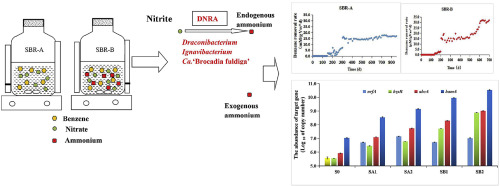当前位置:
X-MOL 学术
›
Chemosphere
›
论文详情
Our official English website, www.x-mol.net, welcomes your
feedback! (Note: you will need to create a separate account there.)
The Co-occurrence of DNRA and Anammox during the anaerobic degradation of benzene under denitrification.
Chemosphere ( IF 8.1 ) Pub Date : 2020-01-21 , DOI: 10.1016/j.chemosphere.2020.125968 Xinkuan Han 1 , Shuchan Peng 1 , Lilan Zhang 2 , Peili Lu 2 , Daijun Zhang 2
Chemosphere ( IF 8.1 ) Pub Date : 2020-01-21 , DOI: 10.1016/j.chemosphere.2020.125968 Xinkuan Han 1 , Shuchan Peng 1 , Lilan Zhang 2 , Peili Lu 2 , Daijun Zhang 2
Affiliation

|
It was revealed that Anammox process promotes the anaerobic degradation of benzene under denitrification. This study investigates the effect of dissimilatory nitrate reduction to ammonium (DNRA) and exogenous ammonium on anaerobic ammonium oxidation bacteria (AnAOB) during the anaerobic degradation of benzene under denitrification. The results indicate that anammox occurs synergistically with organisms using the DNRA pathway, such as Draconibacterium and Ignavibacterium. Phylogenetic analysis showed 64% (16/25) and 36% (5/25) hzsB gene sequences, a specific biomarker of AnAOB, belonged to Candidatus 'Brocadia fuldiga' and Candidatus 'Kuenenia', respectively. Exogenous ammonium addition enhanced the anammox process and accelerated benzene degradation at a 1.89-fold higher average rate compared to that in the absence of exogenous ammonium and AnAOB belonged to Ca. 'Kuenenia' (84%) and Ca. 'Brocadia fuldiga' (16%). These results indicate that Ca. 'Brocadia fuldiga' could also play a role in DNRA. However, the diversity of abcA and bamA, the key anaerobic benzene metabolism biomarkers, remained unchanged. These findings suggest that anammox occurrence may be coupled with DNRA or exogenous ammonium and that anammox promotes anaerobic benzene degradation under denitrifying conditions. The results of this study contribute to understanding the co-occurrence of DNRA and Anammox and help explore their involvement in degradation of benzene, which will be crucial for directing remediation strategies of benzene-contaminated anoxic environment.
中文翻译:

DNRA和Anammox在反硝化作用下苯的厌氧降解过程中同时存在。
结果表明,厌氧氨氧化工艺促进了反硝化作用下苯的厌氧降解。本研究探讨了反硝化作用下苯在厌氧降解过程中异化硝酸盐还原成铵(DNRA)和外源铵对厌氧铵氧化细菌(AnAOB)的影响。结果表明,厌氧氨纶与使用DNRA途径的生物(如吸管杆菌和食管杆菌)协同发生。系统发育分析表明,64%(16/25)和36%(5/25)的hzsB基因序列是AnAOB的特定生物标记,分别属于Candidatus'Brocadia fuldiga'和Candidatus'Kuenenia'。外源铵的加入增强了厌氧氨氧化过程,并在1时加速了苯的降解。与不存在外源铵盐的情况相比,平均速率高89倍,而AnAOB属于Ca。'Kuenenia'(84%)和Ca。'Brocadia fuldiga'(16%)。这些结果表明Ca。'Brocadia fuldiga'也可能在DNRA中起作用。然而,关键的厌氧苯代谢生物标志物abcA和bamA的多样性保持不变。这些发现表明,厌氧菌的发生可能与DNRA或外源铵盐有关,并且厌氧菌在反硝化条件下促进厌氧苯降解。这项研究的结果有助于理解DNRA和Anammox的共存关系,并有助于探索它们与苯降解的关系,这对于指导受苯污染的缺氧环境的修复策略至关重要。Kuenenia'(84%)和Ca。'Brocadia fuldiga'(16%)。这些结果表明Ca。'Brocadia fuldiga'也可能在DNRA中起作用。然而,关键的厌氧苯代谢生物标志物abcA和bamA的多样性保持不变。这些发现表明,厌氧氨水的发生可能与DNRA或外源性铵结合,并且厌氧氨水在反硝化条件下促进厌氧苯降解。这项研究的结果有助于理解DNRA和Anammox的共存关系,并有助于探索它们与苯降解的关系,这对于指导受苯污染的缺氧环境的修复策略至关重要。Kuenenia'(84%)和Ca。'Brocadia fuldiga'(16%)。这些结果表明Ca。'Brocadia fuldiga'也可能在DNRA中起作用。然而,关键的厌氧苯代谢生物标志物abcA和bamA的多样性保持不变。这些发现表明,厌氧菌的发生可能与DNRA或外源铵盐有关,并且厌氧菌在反硝化条件下促进厌氧苯降解。这项研究的结果有助于理解DNRA和Anammox的共存关系,并有助于探索它们与苯降解的关系,这对于指导受苯污染的缺氧环境的修复策略至关重要。关键的厌氧苯代谢生物标志物abcA和bamA的多样性保持不变。这些发现表明,厌氧菌的发生可能与DNRA或外源铵盐有关,并且厌氧菌在反硝化条件下促进厌氧苯降解。这项研究的结果有助于理解DNRA和Anammox的共存关系,并有助于探索它们与苯降解的关系,这对于指导受苯污染的缺氧环境的修复策略至关重要。关键的厌氧苯代谢生物标志物abcA和bamA的多样性保持不变。这些发现表明,厌氧菌的发生可能与DNRA或外源铵盐有关,并且厌氧菌在反硝化条件下促进厌氧苯降解。这项研究的结果有助于理解DNRA和Anammox的共存关系,并有助于探索它们与苯降解的关系,这对于指导受苯污染的缺氧环境的修复策略至关重要。
更新日期:2020-01-22
中文翻译:

DNRA和Anammox在反硝化作用下苯的厌氧降解过程中同时存在。
结果表明,厌氧氨氧化工艺促进了反硝化作用下苯的厌氧降解。本研究探讨了反硝化作用下苯在厌氧降解过程中异化硝酸盐还原成铵(DNRA)和外源铵对厌氧铵氧化细菌(AnAOB)的影响。结果表明,厌氧氨纶与使用DNRA途径的生物(如吸管杆菌和食管杆菌)协同发生。系统发育分析表明,64%(16/25)和36%(5/25)的hzsB基因序列是AnAOB的特定生物标记,分别属于Candidatus'Brocadia fuldiga'和Candidatus'Kuenenia'。外源铵的加入增强了厌氧氨氧化过程,并在1时加速了苯的降解。与不存在外源铵盐的情况相比,平均速率高89倍,而AnAOB属于Ca。'Kuenenia'(84%)和Ca。'Brocadia fuldiga'(16%)。这些结果表明Ca。'Brocadia fuldiga'也可能在DNRA中起作用。然而,关键的厌氧苯代谢生物标志物abcA和bamA的多样性保持不变。这些发现表明,厌氧菌的发生可能与DNRA或外源铵盐有关,并且厌氧菌在反硝化条件下促进厌氧苯降解。这项研究的结果有助于理解DNRA和Anammox的共存关系,并有助于探索它们与苯降解的关系,这对于指导受苯污染的缺氧环境的修复策略至关重要。Kuenenia'(84%)和Ca。'Brocadia fuldiga'(16%)。这些结果表明Ca。'Brocadia fuldiga'也可能在DNRA中起作用。然而,关键的厌氧苯代谢生物标志物abcA和bamA的多样性保持不变。这些发现表明,厌氧氨水的发生可能与DNRA或外源性铵结合,并且厌氧氨水在反硝化条件下促进厌氧苯降解。这项研究的结果有助于理解DNRA和Anammox的共存关系,并有助于探索它们与苯降解的关系,这对于指导受苯污染的缺氧环境的修复策略至关重要。Kuenenia'(84%)和Ca。'Brocadia fuldiga'(16%)。这些结果表明Ca。'Brocadia fuldiga'也可能在DNRA中起作用。然而,关键的厌氧苯代谢生物标志物abcA和bamA的多样性保持不变。这些发现表明,厌氧菌的发生可能与DNRA或外源铵盐有关,并且厌氧菌在反硝化条件下促进厌氧苯降解。这项研究的结果有助于理解DNRA和Anammox的共存关系,并有助于探索它们与苯降解的关系,这对于指导受苯污染的缺氧环境的修复策略至关重要。关键的厌氧苯代谢生物标志物abcA和bamA的多样性保持不变。这些发现表明,厌氧菌的发生可能与DNRA或外源铵盐有关,并且厌氧菌在反硝化条件下促进厌氧苯降解。这项研究的结果有助于理解DNRA和Anammox的共存关系,并有助于探索它们与苯降解的关系,这对于指导受苯污染的缺氧环境的修复策略至关重要。关键的厌氧苯代谢生物标志物abcA和bamA的多样性保持不变。这些发现表明,厌氧菌的发生可能与DNRA或外源铵盐有关,并且厌氧菌在反硝化条件下促进厌氧苯降解。这项研究的结果有助于理解DNRA和Anammox的共存关系,并有助于探索它们与苯降解的关系,这对于指导受苯污染的缺氧环境的修复策略至关重要。











































 京公网安备 11010802027423号
京公网安备 11010802027423号